stop start FORD F650 2015 13.G User Guide
[x] Cancel search | Manufacturer: FORD, Model Year: 2015, Model line: F650, Model: FORD F650 2015 13.GPages: 384, PDF Size: 4.95 MB
Page 100 of 384

3. Do not press the accelerator pedal, service brake pedal, or clutch
pedal (manual transmission).
4. The parking brake must remain set.
On average, depending on filter level and other factors, the process takes
20–30 minutes to complete. The DPF lamp turns off when the process is
complete. Repeat Steps 1–5, if parked regeneration is interrupted.
To Discontinue Parked Regeneration
Press any of the floor pedals to discontinue parked regeneration.
Maintenance and Service
The DPF can retain a relatively large amount of residual ash and provide
many miles and hours of maintenance-free operation. At some point,
generally beyond 150000 miles (240000 kilometers) or 5000 hours of
operation (whichever comes first), the DPF requires professional
cleaning to remove the accumulated ash.
The exact number of miles or hours of operation vary greatly depending
upon vehicle and engine loading and operating conditions, ash content of
the engine oil, and quality of the diesel fuel used in your truck. Adhering
to your engine manufacturer’s recommended oil and fuel specifications
maximizes the miles and hours of operation before a DPF professional
cleaning is required. See your engine manufacturer’s owner’s manual for
more details about recommended maintenance and service of your DPF.
Exhaust Outlet Assembly
WARNING:The normal operating temperature of the exhaust
system is very high. Never work around or attempt to repair any
part of the exhaust system until it has cooled. Failure to follow these
instructions may result in serious personal injury.
Note:Do not modify or remove this device. Modification of the system
or additions of aftermarket devices can reduce the effectiveness of the
system, as well as cause damage to the exhaust system or engine. Any
modifications may also invalidate the vehicle or engine warranty. See
your warranty information.
Note:Blocked or plugged holes or modification to, or removal of, the
outlet assembly could result in elevated exhaust temperatures that may
result in vehicle or property damage or personal injury.
The exhaust outlet assembly on your vehicle is a uniquely functioning
device that accompanies the DPF assembly. It can help control the
temperature of the exhaust during the DPF regeneration process.
Starting and Stopping the Engine99
2015 F-650/750(f67)
Owners Guide gf(ownloose), 1st Printing, December 2013
Canadian_French(fr_can)
Page 101 of 384
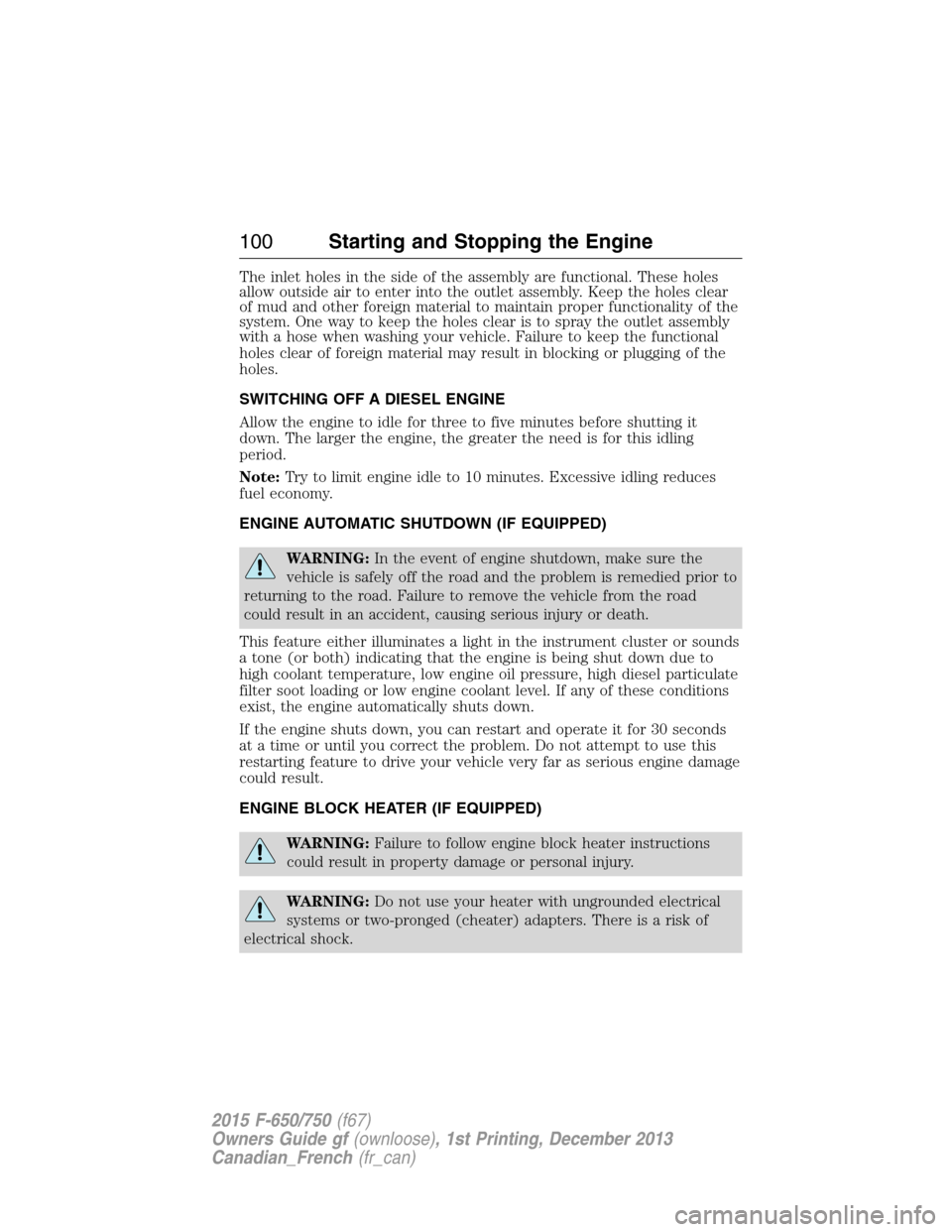
The inlet holes in the side of the assembly are functional. These holes
allow outside air to enter into the outlet assembly. Keep the holes clear
of mud and other foreign material to maintain proper functionality of the
system. One way to keep the holes clear is to spray the outlet assembly
with a hose when washing your vehicle. Failure to keep the functional
holes clear of foreign material may result in blocking or plugging of the
holes.
SWITCHING OFF A DIESEL ENGINE
Allow the engine to idle for three to five minutes before shutting it
down. The larger the engine, the greater the need is for this idling
period.
Note:Try to limit engine idle to 10 minutes. Excessive idling reduces
fuel economy.
ENGINE AUTOMATIC SHUTDOWN (IF EQUIPPED)
WARNING:In the event of engine shutdown, make sure the
vehicle is safely off the road and the problem is remedied prior to
returning to the road. Failure to remove the vehicle from the road
could result in an accident, causing serious injury or death.
This feature either illuminates a light in the instrument cluster or sounds
a tone (or both) indicating that the engine is being shut down due to
high coolant temperature, low engine oil pressure, high diesel particulate
filter soot loading or low engine coolant level. If any of these conditions
exist, the engine automatically shuts down.
If the engine shuts down, you can restart and operate it for 30 seconds
at a time or until you correct the problem. Do not attempt to use this
restarting feature to drive your vehicle very far as serious engine damage
could result.
ENGINE BLOCK HEATER (IF EQUIPPED)
WARNING:Failure to follow engine block heater instructions
could result in property damage or personal injury.
WARNING:Do not use your heater with ungrounded electrical
systems or two-pronged (cheater) adapters. There is a risk of
electrical shock.
100Starting and Stopping the Engine
2015 F-650/750(f67)
Owners Guide gf(ownloose), 1st Printing, December 2013
Canadian_French(fr_can)
Page 102 of 384
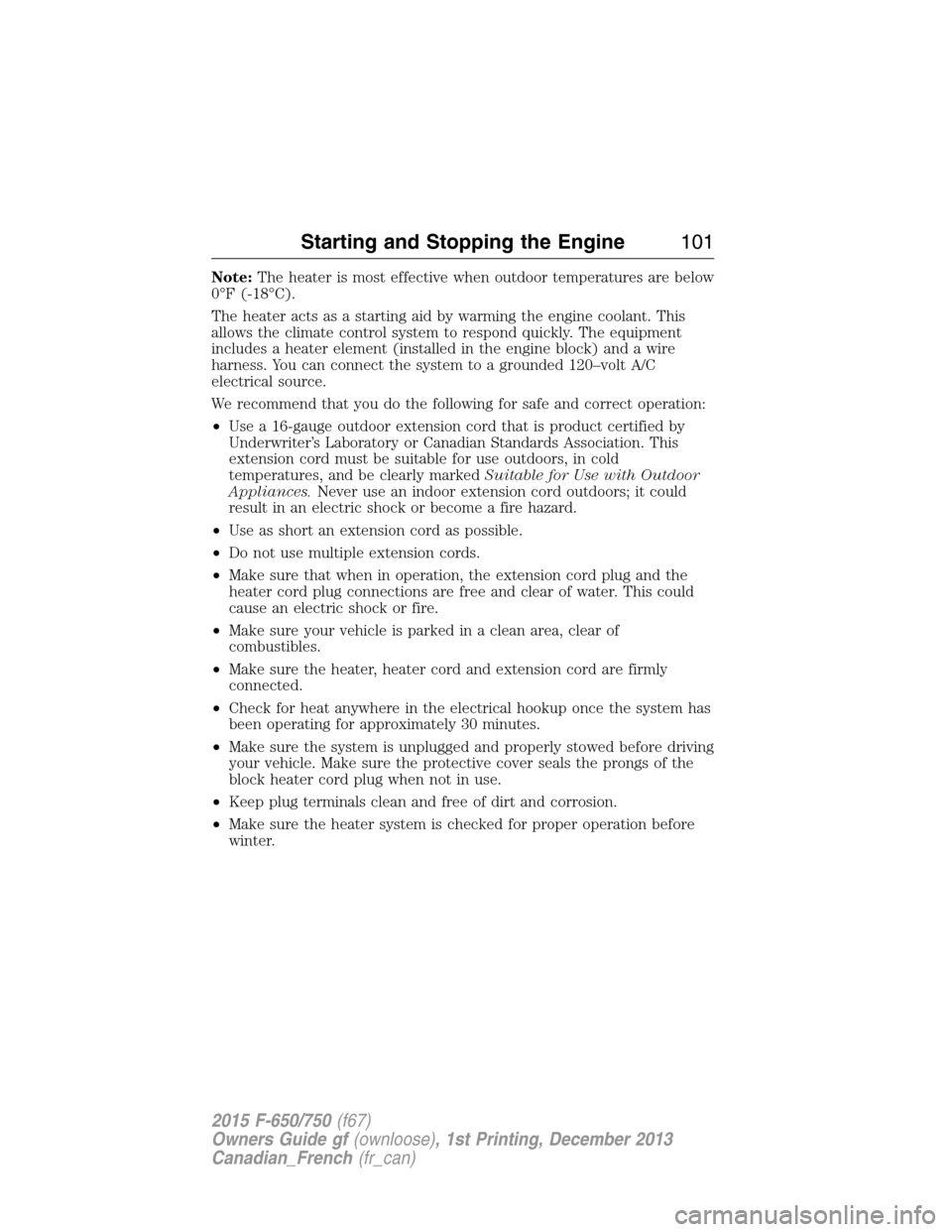
Note:The heater is most effective when outdoor temperatures are below
0°F (-18°C).
The heater acts as a starting aid by warming the engine coolant. This
allows the climate control system to respond quickly. The equipment
includes a heater element (installed in the engine block) and a wire
harness. You can connect the system to a grounded 120–volt A/C
electrical source.
We recommend that you do the following for safe and correct operation:
•Use a 16-gauge outdoor extension cord that is product certified by
Underwriter’s Laboratory or Canadian Standards Association. This
extension cord must be suitable for use outdoors, in cold
temperatures, and be clearly markedSuitable for Use with Outdoor
Appliances.Never use an indoor extension cord outdoors; it could
result in an electric shock or become a fire hazard.
•Use as short an extension cord as possible.
•Do not use multiple extension cords.
•Make sure that when in operation, the extension cord plug and the
heater cord plug connections are free and clear of water. This could
cause an electric shock or fire.
•Make sure your vehicle is parked in a clean area, clear of
combustibles.
•Make sure the heater, heater cord and extension cord are firmly
connected.
•Check for heat anywhere in the electrical hookup once the system has
been operating for approximately 30 minutes.
•Make sure the system is unplugged and properly stowed before driving
your vehicle. Make sure the protective cover seals the prongs of the
block heater cord plug when not in use.
•Keep plug terminals clean and free of dirt and corrosion.
•Make sure the heater system is checked for proper operation before
winter.
Starting and Stopping the Engine101
2015 F-650/750(f67)
Owners Guide gf(ownloose), 1st Printing, December 2013
Canadian_French(fr_can)
Page 103 of 384
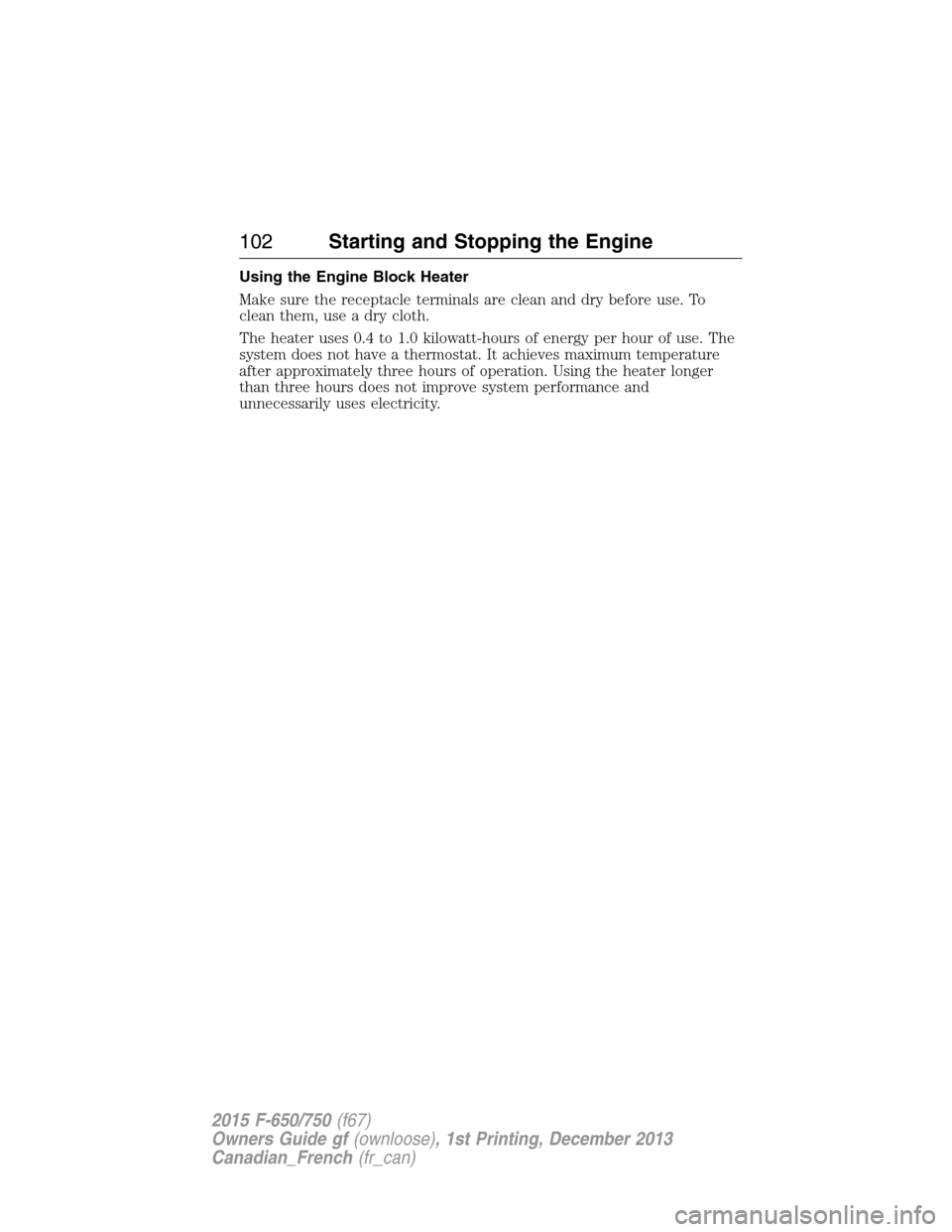
Using the Engine Block Heater
Make sure the receptacle terminals are clean and dry before use. To
clean them, use a dry cloth.
The heater uses 0.4 to 1.0 kilowatt-hours of energy per hour of use. The
system does not have a thermostat. It achieves maximum temperature
after approximately three hours of operation. Using the heater longer
than three hours does not improve system performance and
unnecessarily uses electricity.
102Starting and Stopping the Engine
2015 F-650/750(f67)
Owners Guide gf(ownloose), 1st Printing, December 2013
Canadian_French(fr_can)
Page 108 of 384

If you have run out of fuel:
•If your vehicle is equipped with dual fuel tanks, adding four–five
gallons (15–19 liters) of fuel is enough to restart the engine. If your
vehicle is out of fuel and on a steep grade, more than four–five
gallons (15–19 liters) may be required.
•The fuel system must be primed before attempting to restart the
engine. See your engine operator’s manual for instructions on priming
the engine.
•Use caution not to overheat and damage the starter by cranking the
engine for an excessive period. You may need to crank the engine for
a longer time than normal. If the engine fails to start in 30 seconds,
turn the ignition to the off position and wait for two minutes before
cranking the engine again.
•Any remaining trapped air self-purges from the fuel system once the
engine starts running.
•The engine may run rough and produce white smoke while air is in
the fuel system. This is normal and should stop after a short period.
SeeGeneral informationin theInformation Displayschapter for
information on Miles to Empty.
REFUELING
WARNING:Fuel vapor burns violently and a fuel fire can cause
severe injuries. To help avoid injuries to you and others:
•Read and follow all the instructions on the pump island.
•Turn off your engine when you are refueling.
•Do not smoke if you are near fuel or refueling your vehicle.
•Keep sparks, flames and smoking materials away from fuel.
•Stay outside your vehicle and do not leave the fuel pump unattended
when refueling your vehicle - this is against the law in some places.
•Keep children away from the fuel pump; never let children pump
fuel.
•Do not use personal electronic devices while refueling.
Use the following guidelines to avoid electrostatic charge build-up when
filling an ungrounded fuel container:
•Place approved fuel container on the ground.
•DO NOT fill a fuel container while it is in the vehicle (including the
cargo area).
Fuel and Refueling107
2015 F-650/750(f67)
Owners Guide gf(ownloose), 1st Printing, December 2013
Canadian_French(fr_can)
Page 109 of 384

•Keep the fuel pump nozzle in contact with the fuel container while
filling.
•DO NOT use a device that would hold the fuel pump handle in the fill
position.
Fuel Filler Cap
WARNING:The fuel system may be under pressure. If the fuel
filler cap is venting vapor or if you hear a hissing sound, wait
until it stops before completely removing the fuel filler cap. Otherwise,
fuel may spray out and injure you or others.
WARNING:If you do not use the proper fuel filler cap, excessive
pressure or vacuum in the fuel tank may damage the fuel system
or cause the fuel cap to disengage in a crash, which may result in
possible personal injury.
Note:If you must replace the fuel filler cap, replace it with a fuel filler
cap designed for your vehicle. The customer warranty may be void for
any damage to the fuel tank or fuel system if the correct genuine Ford,
Motorcraft or other certified fuel filler cap is not used.
Your fuel tank filler cap has an indexed design with a quarter–turn on
and off feature. When fueling your vehicle:
1. Turn the engine off.
2. Carefully turn the filler cap counterclockwise until it spins off.
3. Pull to remove the cap from the fuel filler pipe.
4. To install the cap, align the tabs on the cap with the notches on the
filler pipe.
5. Turn the filler cap clockwise a
1�4–turn until it clicks at least once.
If the check fuel cap light appears in the instrument cluster and stays on
after you start the engine, you not have installed the fuel filler cap
properly.
If the fuel cap light remains on, at the next opportunity, safely pull off
the road, remove the fuel filler cap, align the cap properly and reinstall
it. The check fuel cap light may not reset immediately; it may take
several driving cycles for the indicators to turn off. A driving cycle
consists of an engine start-up (after four or more hours with the engine
off) followed by normal city and highway driving.
108Fuel and Refueling
2015 F-650/750(f67)
Owners Guide gf(ownloose), 1st Printing, December 2013
Canadian_French(fr_can)
Page 123 of 384

MANUAL TRANSMISSION OPERATION (IF EQUIPPED)
You can see the manual transmission shift patterns on either the shift
lever knob or the sun visor. Study this information carefully before you
drive your vehicle even though you may be familiar with similar units. Do
not attempt to drive your vehicle without knowing the exact shift pattern
of the transmission. Consult an authorized dealer if any questions exist
as to the shifting instructions posted in your vehicle.
Driving Hints
WARNING:Do not coast the vehicle with the clutch pedal
pressed or with the transmission in neutral. This practice could
result in loss of vehicle control.
The following driving hints are a brief, general guide in operating the
different manual transmissions used in your vehicle.
•When shifting into first gear or reverse with your vehicle standing
still, quickly release and press the clutch pedal (if necessary to
complete gear engagement).
•Always use the lowest (or most appropriate) gear to start your
vehicle.
•Always use a gear ratio low enough to allow the engine to operate
above the minimum engine operation speed range.
•Do not lug the engine.
•Do not slam or jerk the gearshift lever into gear.
•When more power is required, shift to a lower gear and accelerate
the engine near the governed speed.
To go forward, press the clutch pedal in and shift into first gear while
the engine is idling. Engage the clutch while pressing the accelerator to
start forward. Operate the clutch and upshift as required by driving
conditions.
To go backward, put the gearshift lever in reverse and engaging the
clutch while pressing lightly on the accelerator.
Shifting with a Synchronized Transmission
With the clutch pedal pressed in, use the second gear synchronizer to
stop the clutch disc rotation, this allows smooth engagement of first gear
or reverse. To complete the gear engagement, it may be necessary to
apply light pressure to the gearshift lever during initial engagement of
the clutch. It takes a second or two to match gear speeds; steady
pressure on the gearshift lever helps the synchronizer perform its job
122Transmission
2015 F-650/750(f67)
Owners Guide gf(ownloose), 1st Printing, December 2013
Canadian_French(fr_can)
Page 125 of 384
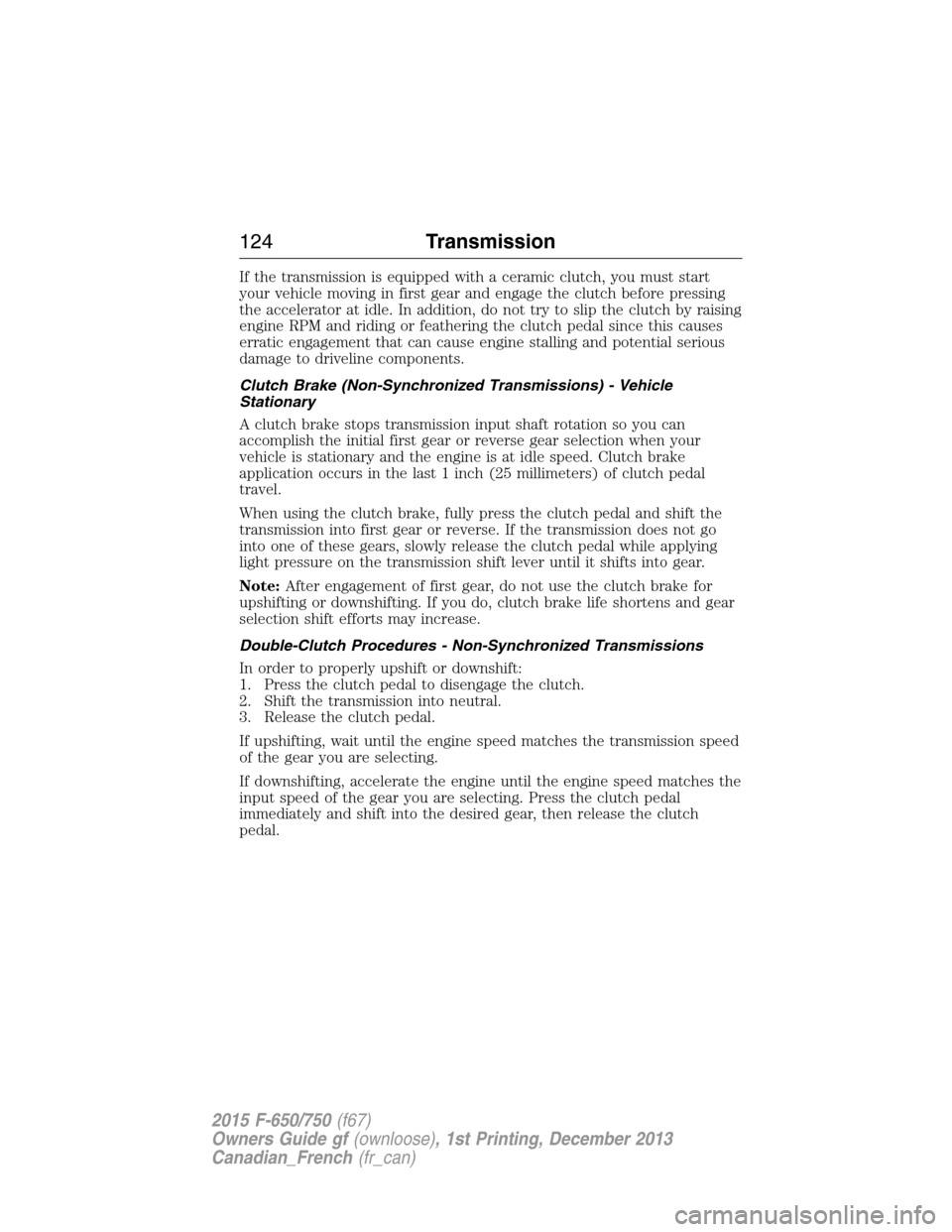
If the transmission is equipped with a ceramic clutch, you must start
your vehicle moving in first gear and engage the clutch before pressing
the accelerator at idle. In addition, do not try to slip the clutch by raising
engine RPM and riding or feathering the clutch pedal since this causes
erratic engagement that can cause engine stalling and potential serious
damage to driveline components.
Clutch Brake (Non-Synchronized Transmissions) - Vehicle
Stationary
A clutch brake stops transmission input shaft rotation so you can
accomplish the initial first gear or reverse gear selection when your
vehicle is stationary and the engine is at idle speed. Clutch brake
application occurs in the last 1 inch (25 millimeters) of clutch pedal
travel.
When using the clutch brake, fully press the clutch pedal and shift the
transmission into first gear or reverse. If the transmission does not go
into one of these gears, slowly release the clutch pedal while applying
light pressure on the transmission shift lever until it shifts into gear.
Note:After engagement of first gear, do not use the clutch brake for
upshifting or downshifting. If you do, clutch brake life shortens and gear
selection shift efforts may increase.
Double-Clutch Procedures - Non-Synchronized Transmissions
In order to properly upshift or downshift:
1. Press the clutch pedal to disengage the clutch.
2. Shift the transmission into neutral.
3. Release the clutch pedal.
If upshifting, wait until the engine speed matches the transmission speed
of the gear you are selecting.
If downshifting, accelerate the engine until the engine speed matches the
input speed of the gear you are selecting. Press the clutch pedal
immediately and shift into the desired gear, then release the clutch
pedal.
124Transmission
2015 F-650/750(f67)
Owners Guide gf(ownloose), 1st Printing, December 2013
Canadian_French(fr_can)
Page 130 of 384
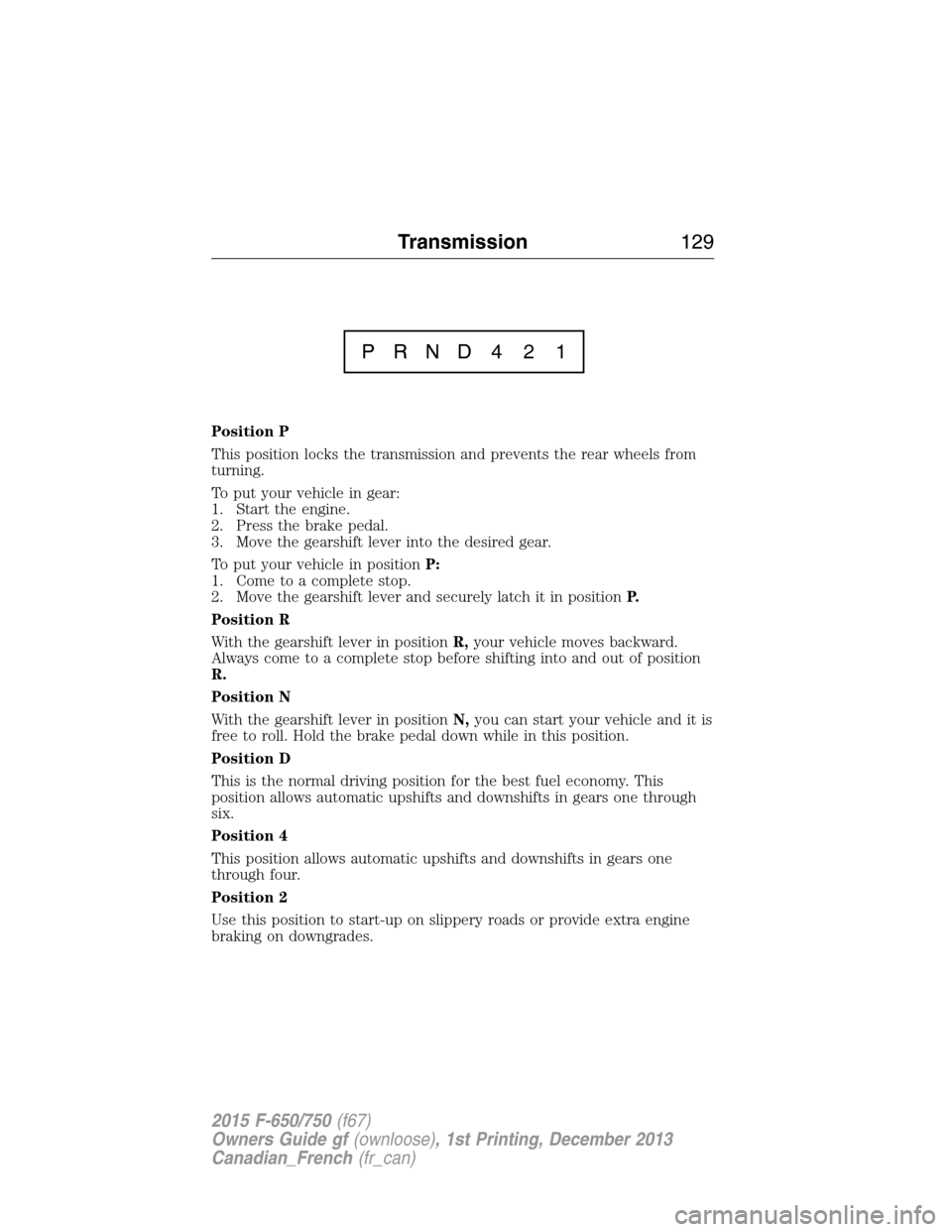
Position P
This position locks the transmission and prevents the rear wheels from
turning.
To put your vehicle in gear:
1. Start the engine.
2. Press the brake pedal.
3. Move the gearshift lever into the desired gear.
To put your vehicle in positionP:
1. Come to a complete stop.
2. Move the gearshift lever and securely latch it in positionP.
Position R
With the gearshift lever in positionR,your vehicle moves backward.
Always come to a complete stop before shifting into and out of position
R.
Position N
With the gearshift lever in positionN,you can start your vehicle and it is
free to roll. Hold the brake pedal down while in this position.
Position D
This is the normal driving position for the best fuel economy. This
position allows automatic upshifts and downshifts in gears one through
six.
Position 4
This position allows automatic upshifts and downshifts in gears one
through four.
Position 2
Use this position to start-up on slippery roads or provide extra engine
braking on downgrades.
PRND 4 2 1
Transmission129
2015 F-650/750(f67)
Owners Guide gf(ownloose), 1st Printing, December 2013
Canadian_French(fr_can)
Page 132 of 384
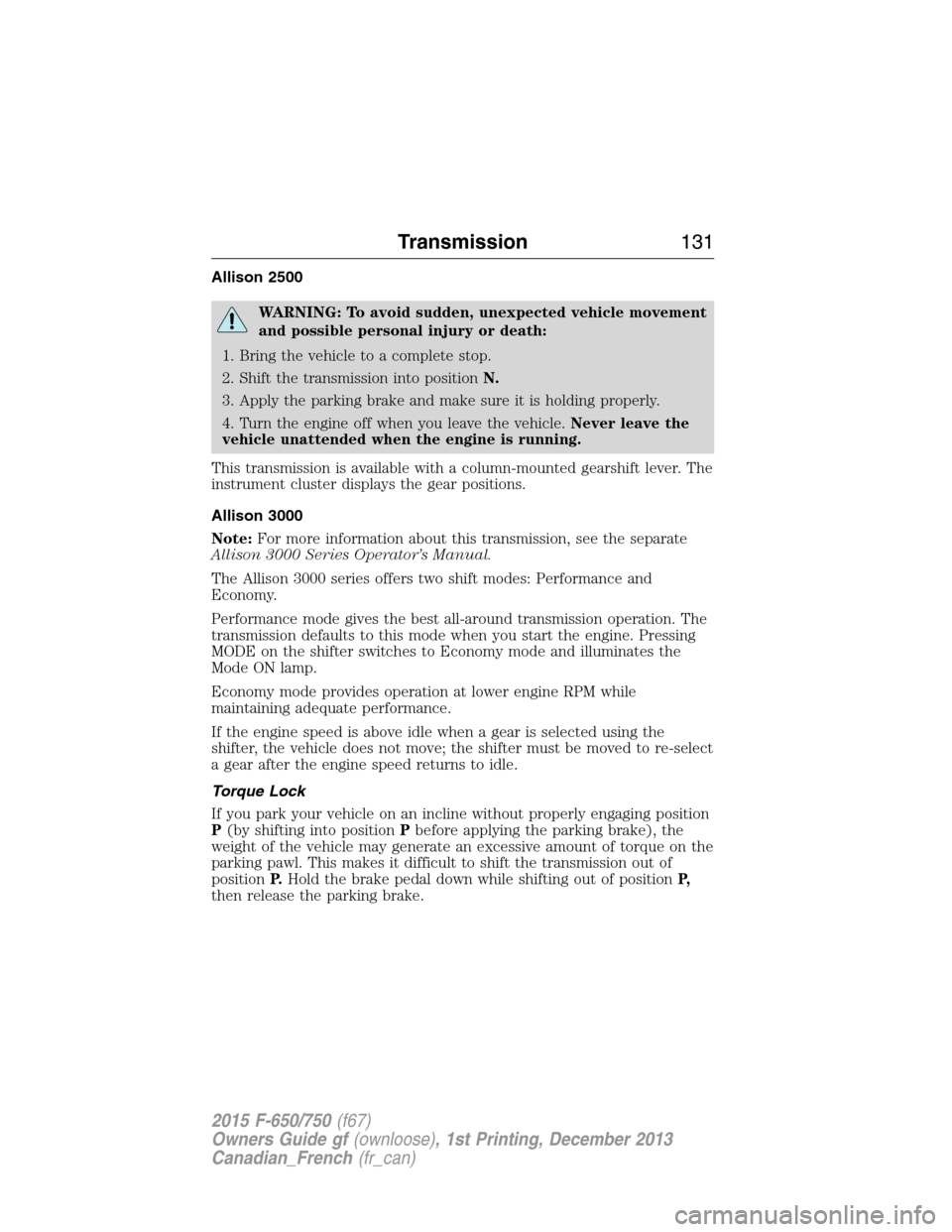
Allison 2500
WARNING: To avoid sudden, unexpected vehicle movement
and possible personal injury or death:
1. Bring the vehicle to a complete stop.
2. Shift the transmission into positionN.
3. Apply the parking brake and make sure it is holding properly.
4. Turn the engine off when you leave the vehicle.Never leave the
vehicle unattended when the engine is running.
This transmission is available with a column-mounted gearshift lever. The
instrument cluster displays the gear positions.
Allison 3000
Note:For more information about this transmission, see the separate
Allison 3000 Series Operator’s Manual.
The Allison 3000 series offers two shift modes: Performance and
Economy.
Performance mode gives the best all-around transmission operation. The
transmission defaults to this mode when you start the engine. Pressing
MODE on the shifter switches to Economy mode and illuminates the
Mode ON lamp.
Economy mode provides operation at lower engine RPM while
maintaining adequate performance.
If the engine speed is above idle when a gear is selected using the
shifter, the vehicle does not move; the shifter must be moved to re-select
a gear after the engine speed returns to idle.
Torque Lock
If you park your vehicle on an incline without properly engaging position
P(by shifting into positionPbefore applying the parking brake), the
weight of the vehicle may generate an excessive amount of torque on the
parking pawl. This makes it difficult to shift the transmission out of
positionP.Hold the brake pedal down while shifting out of positionP,
then release the parking brake.
Transmission131
2015 F-650/750(f67)
Owners Guide gf(ownloose), 1st Printing, December 2013
Canadian_French(fr_can)